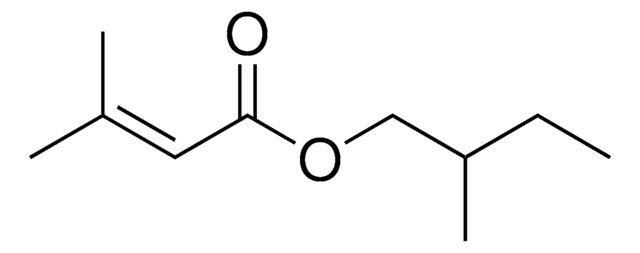About This Item
おすすめの製品
由来生物
synthetic
品質水準
グレード
Fragrance grade
Halal
Kosher
認証
follows IFRA guidelines
法規制遵守
EU Regulation 1223/2009
FDA 21 CFR 117
含みます
α-tocopherol as stabilizer (synthetic)
濃度
50% in triacetin
屈折率
n20/D 1.44
bp
20 °C/0.2 mmHg
密度
0.982 g/mL at 25 °C
アプリケーション
flavors and fragrances
文書
see Safety & Documentation for available documents
食物アレルゲン
no known allergens
香料中のアレルゲン
no known allergens
官能
apple; fatty; green; fruity
保管温度
2-8°C
SMILES記法
CC\C=C/CC=O
InChI
1S/C6H10O/c1-2-3-4-5-6-7/h3-4,6H,2,5H2,1H3/b4-3-
InChI Key
GXANMBISFKBPEX-ARJAWSKDSA-N
関連するカテゴリー
アプリケーション
免責事項
シグナルワード
Warning
危険有害性情報
危険有害性の分類
Eye Irrit. 2 - Flam. Liq. 3
保管分類コード
3 - Flammable liquids
WGK
WGK 3
引火点(°F)
96.0 °F
引火点(℃)
35.55 °C
個人用保護具 (PPE)
Eyeshields, Faceshields, Gloves, type ABEK (EN14387) respirator filter
適用法令
試験研究用途を考慮した関連法令を主に挙げております。化学物質以外については、一部の情報のみ提供しています。 製品を安全かつ合法的に使用することは、使用者の義務です。最新情報により修正される場合があります。WEBの反映には時間を要することがあるため、適宜SDSをご参照ください。
消防法
第4類:引火性液体
第二石油類
危険等級III
非水溶性液体
Jan Code
W256102-SAMPLE-K:
W256102-100G-K:
W256102-1KG:
W256102-25G:
W256102-SAMPLE:
W256102-25G-K:
W256102-1KG-K:
W256102-BULK-K:
W256102-VAR-K:
W256102-100G:
この製品を見ている人はこちらもチェック
アクティブなフィルタ
ライフサイエンス、有機合成、材料科学、クロマトグラフィー、分析など、あらゆる分野の研究に経験のあるメンバーがおります。.
製品に関するお問い合わせはこちら(テクニカルサービス)











